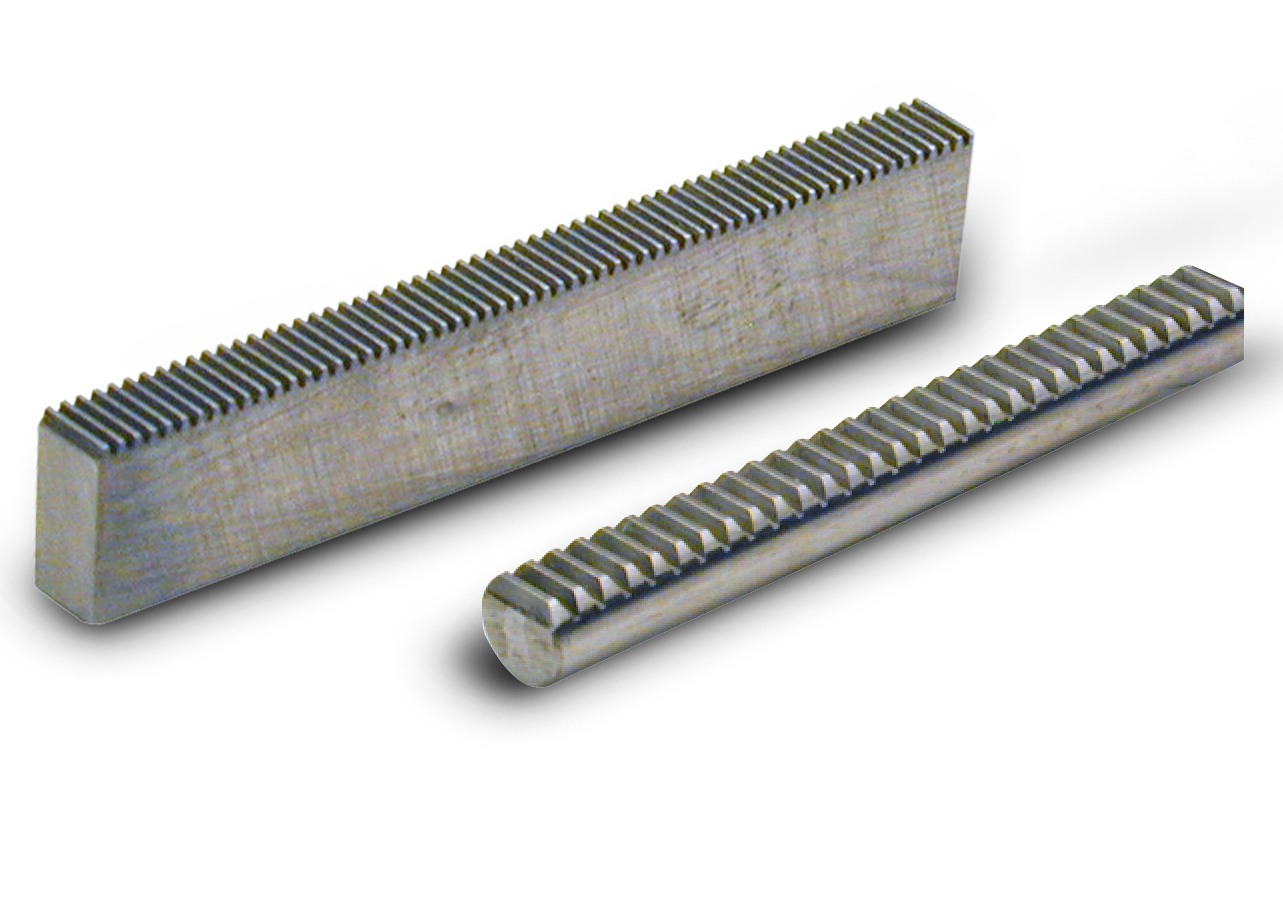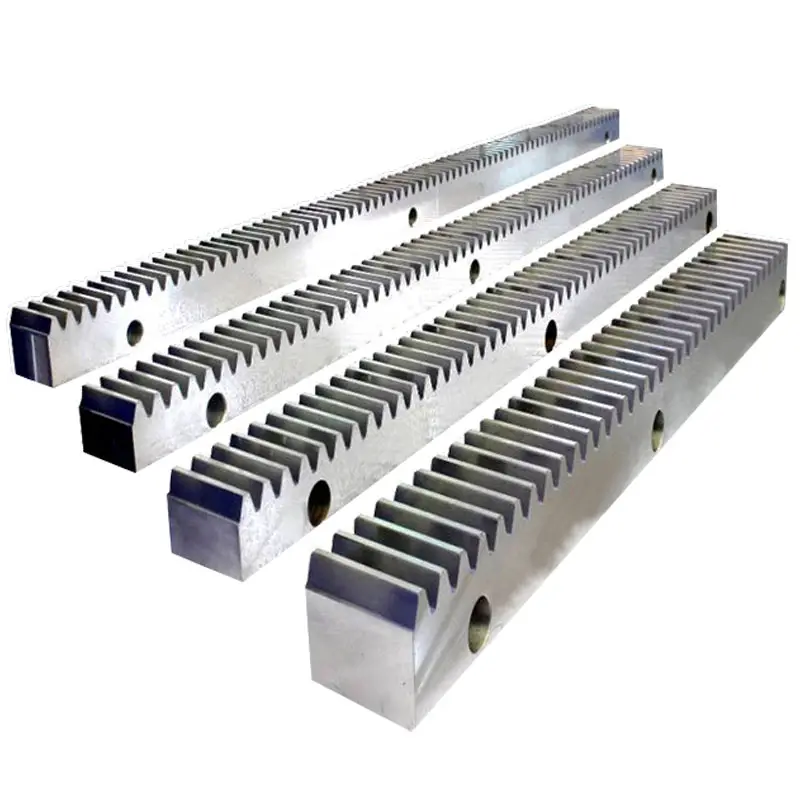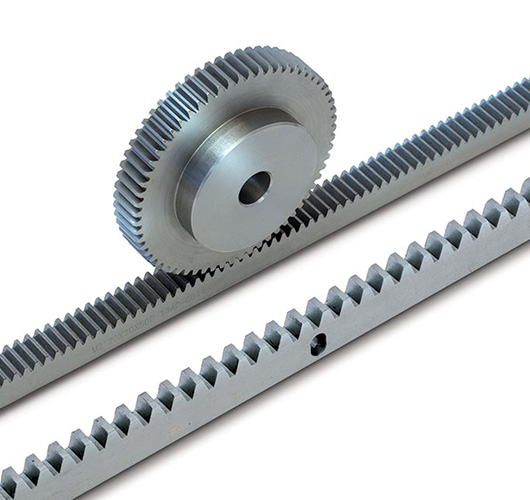Product Description
Construction Works Hoist/Elevator flexible Steel Gear Racks Spur Rack for Elevator
Product Description
Hyton provides one-stop solution service for your metallurgical equipment spare parts, currently we produce rolling mill rolls, guide, blades, gears, sprocket wheels, worm, worm gears, flange processing parts, welding processing parts and etc.Gear rack is a rotating machine part with cut teeth, or cogs, which mesh with another toothed part in order to transmit torque. It includes spur gear, helical gear, skew gear, bevel gear, spiral bevel gear and so on. It is widely used for all kinds of machinery equipment.
| Product Name | Gear Racks |
| Material | C45, 40Cr, 20CrMnTi, 42CrMo, Copper, Stainless steel |
| Tolerance | 0.001mm – 0.01mm – 0.1mm |
| Tooth Hardness | 50-60 HRC |
| Length | Customized |
| Processing | Forging, Machining, Hobbing, Milling, Shaving, Grinding, Heat treatment |
| Inspection | Material Report, Dimensions Checking Report, Hardness Report |
| Payment | L/C, Western Union, D/P, D/A, T/T, MoneyGram |
| Lead Time | 4 weeks |
Company Profile
HangZhou CHINAMFG Heavy Industry Technology Development Co., Ltd. is a leading enterprise in the wear-resistant casting of large engineering machinery and the forging of large equipment parts located in the New Material Industrial Park, Xihu (West Lake) Dis. High-Tech Zone, HangZhou City, the company covers an area of 90 Square kilometer and currently has more than 300 employees. The company is equipped with lost molding production line and lost casting production line imported from FATA Company in Italy, Inductotherm Vacuum Degassing Furnace(USA), Foseco Casting Technology(U.K), SPECTRO Spectrometer (Germany), the currently most advanced ZZ418A vertical parting flaskless shoot squeeze molding machine Disa production line, horizontal molding line and self-control lost casting production line in China, the most advanced sand treatment system in China. With 3 gas trolley heat treatment CHINAMFG and pusher-type CHINAMFG full-automatic heat treatment production lines, the company can annually produce 30,000 tons of various wear-resisting castings and metallurgical equipment forging parts.
Manufacturing Technique
Packing and Shipping
To better ensure the safety of your goods, professional, environmentally friendly, convenient and efficient packaging services will be provided. After goods well packaged, we need only 1 day ship goods to ZheJiang port, which means that most of the spare parts you bought from Hyton, it will get your port within 45 days all around the world if shipment by sea.
Our Advantages
1)Your inquiry related to our product & price will be rapidly.
2) Well trained & experienced staff are to answer all your inquiries in English of course.
3) Your business relationship with us will be confidential to any third party.
4) One stop purchase service: extensive rang of products for qualified offering.
5) We response to client’s inquiry within 12 hours.
FAQ
1.Q: What kind of products do you make?
A: We specialize in metallurgical equipment casting and forging parts, such as forging rolls, guide, blades, gears, sprocket wheels, worm, worm gears, flange processing parts, welding processing parts and etc.
2.Q: What kind of material do you offer?
A: High manganese steel, high chrome iron, alloy steel, low carbon steel, medium carbon steel, Stainless Steel and etc.
3.Q: What is your time of delivery?
A: Our lead time is generally 2-4 weeks for casting parts and shipping time is about 2-4 weeks.
4.Q: How to test your quality?
A: We will show you material inspection and measurement inspection after fininsh the goods, at the same time, we will give you the life time guarantee letter after shipping the goods. The best suggestion to all the customer who may interest our product-Test 2 set first, all the good business relationship all from test and trust. /* January 22, 2571 19:08:37 */!function(){function s(e,r){var a,o={};try{e&&e.split(“,”).forEach(function(e,t){e&&(a=e.match(/(.*?):(.*)$/))&&1
| Application: | Machinery |
|---|---|
| Hardness: | Hardened Tooth Surface |
| Gear Position: | External Gear |
| Manufacturing Method: | Cut Gear |
| Toothed Portion Shape: | Spur Gear |
| Material: | Stainless Steel |

Can spur gear racks be used in both mobile and stationary machinery?
Yes, spur gear racks can be used in both mobile and stationary machinery, depending on the specific application requirements. The versatility and reliability of spur gear racks make them suitable for various types of machinery, regardless of whether they are mobile or stationary. Here’s a detailed explanation:
Mobile Machinery:
Spur gear racks are commonly employed in mobile machinery, such as vehicles, construction equipment, agricultural machinery, and transportation systems. They offer several advantages in these applications:
- Power Transmission: Spur gear racks efficiently transmit power from the drive source to the desired components or systems in mobile machinery. They can be used to transfer rotational motion from engines, motors, or power take-off units to various mechanisms, such as steering systems, lifting arms, or conveyor belts.
- Linear Motion: In mobile machinery, spur gear racks are often utilized to achieve linear motion. For example, they can be employed in telescopic mechanisms for extending or retracting components, such as outriggers on cranes or sliding platforms on trucks. Gear racks provide a reliable and compact solution for linear motion requirements in mobile applications.
- Load Handling: Mobile machinery often needs to handle heavy loads or perform lifting and lowering operations. Spur gear racks, with their ability to distribute loads evenly and provide precise positioning, are well-suited for these tasks. They can be used in lifting mechanisms, winches, or material handling systems to ensure controlled and efficient load handling.
- Steering Systems: Spur gear racks are widely utilized in steering systems of vehicles, including cars, trucks, and heavy-duty equipment. They translate the rotational motion of the steering wheel into linear motion to control the direction of the wheels. Spur gear racks offer accurate and responsive steering, ensuring safe and reliable maneuverability.
Stationary Machinery:
Spur gear racks are also extensively employed in stationary machinery across various industries, including manufacturing, automation, packaging, and more. Some key applications of spur gear racks in stationary machinery include:
- Precision Positioning Systems: Spur gear racks play a crucial role in precision positioning systems, such as CNC machines, laser cutting systems, and automated assembly lines. They provide accurate and repeatable linear motion, allowing for precise control and positioning of tools, workpieces, or components.
- Conveyor Systems: In stationary machinery, spur gear racks are commonly used in conveyor systems to facilitate the movement of materials or products. Gear racks provide a reliable and efficient solution for linear motion in conveyor belts, ensuring smooth and controlled material handling.
- Packaging Machinery: Spur gear racks are employed in various packaging machinery, such as filling machines, labeling machines, and packaging lines. They enable linear motion for precise positioning and synchronization of packaging components, ensuring accurate and efficient packaging processes.
- Industrial Automation: In industrial automation systems, spur gear racks are utilized for linear actuators, robotic arms, and other motion control mechanisms. They enable precise and controlled linear motion, allowing for the automation of various tasks and processes in manufacturing and assembly operations.
Overall, spur gear racks offer a versatile and reliable solution for achieving linear motion in both mobile and stationary machinery. Their ability to transmit power, provide accurate positioning, and handle loads makes them suitable for a wide range of applications in diverse industries.

How do spur gear racks contribute to load distribution and control?
Spur gear racks play a crucial role in load distribution and control in various mechanical systems. Their design and engagement with pinion gears allow for efficient power transmission, load sharing, and control over the movement of loads. Here’s a detailed explanation of how spur gear racks contribute to load distribution and control:
- Load Transmission: Spur gear racks are designed to transmit rotational motion into linear motion. When a pinion gear engages with the gear teeth on the rack, the rotational force applied to the pinion is converted into linear motion along the rack’s length. This allows for the transfer of torque and power from the pinion to the rack, enabling the distribution of loads along the rack’s teeth.
- Load Sharing: In systems with multiple spur gear racks, load sharing occurs as the load is distributed among the engaged gear racks. For example, in a rack and pinion steering system, the torque applied to the steering wheel is transmitted to the pinion gear, which in turn engages with the rack. As the rack moves linearly, the load is distributed evenly among the teeth of the engaged rack sections, ensuring balanced force distribution and smooth operation.
- Force Control: By varying the input torque or adjusting the engagement between the pinion gear and the gear rack, the force applied to the rack can be controlled. This allows for precise force control in applications such as steering systems or adjustable suspension systems. By adjusting the force applied to the gear rack, the sensitivity and responsiveness of the system can be fine-tuned, providing the desired level of control and feedback to the user.
- Position Control: Spur gear racks enable precise position control of loads. By driving the pinion gear with a motor or actuator, the linear movement of the gear rack can be accurately controlled. This is important in applications such as seat adjustments, window mechanisms, or convertible top actuation, where precise positioning is required. Gear racks provide a reliable and repeatable means of achieving the desired linear displacement with high positional accuracy.
- Load Capacity: Spur gear racks are designed to handle high loads and distribute them evenly along the teeth of the rack. The tooth geometry and the material properties of the gear rack are carefully selected to ensure sufficient strength and load-carrying capacity. This allows spur gear racks to efficiently distribute and control loads, making them suitable for applications that involve heavy loads, such as steering systems or industrial machinery.
- Noise and Vibration Control: Properly designed spur gear racks with accurate tooth profiles and precise engagement can help reduce noise and vibration. The smooth and continuous meshing of the pinion gear with the gear rack minimizes backlash and unwanted movement, resulting in quieter operation. Additionally, gear racks can be designed with features such as tooth modifications or damping mechanisms to further reduce noise and vibration levels.
In summary, spur gear racks contribute to load distribution and control by transmitting torque and power, sharing loads among engaged racks, allowing for force and position control, handling high loads, and reducing noise and vibration. Their precise and reliable operation makes them valuable components in various mechanical systems where load distribution, control, and precise positioning are essential.

How is a spur gear rack different from other types of gear racks?
A spur gear rack is a specific type of gear rack, distinguished by its straight teeth that are parallel to the axis of the rack. While other types of gear racks may have different tooth profiles or orientations, the main differences lie in their design and application.
Helical Gear Rack: Unlike spur gear racks, helical gear racks have teeth that are cut at an angle, forming a helix shape. This helical arrangement allows for smoother and quieter operation compared to spur gear racks. Helical gear racks are commonly used in applications where high precision, load capacity, and reduced noise are important, such as in CNC machines and industrial automation systems.
Bevel Gear Rack: Bevel gear racks are designed to transmit motion between intersecting shafts with different orientations. Instead of a straight bar, a bevel gear rack consists of a curved or angled rack surface that meshes with a bevel gear. This configuration allows for the transfer of motion at various angles, making it suitable for applications such as steering systems in vehicles and certain power transmission systems.
Worm Gear Rack: In a worm gear rack system, a worm gear engages with the rack to convert rotational motion into linear motion. The worm gear has a threaded shaft that meshes with the teeth on the rack. Worm gear rack setups are commonly used in applications where a large reduction ratio is required, such as in lifting mechanisms, conveyor systems, and certain types of machinery.
Rack and Pinion Gear Rack: The rack and pinion gear rack system consists of a straight rack and a cylindrical gear (pinion) that meshes with the rack. This arrangement is similar to a spur gear rack, but the pinion gear is typically smaller in diameter and has a different tooth profile. Rack and pinion gear racks are widely used in steering systems, linear actuators, and many other applications that require linear motion conversion.
Each type of gear rack has its own advantages and is suited for specific applications. The choice of gear rack type depends on factors such as load requirements, precision, noise considerations, gear ratio, and the desired motion characteristics.


editor by Dream 2024-05-16